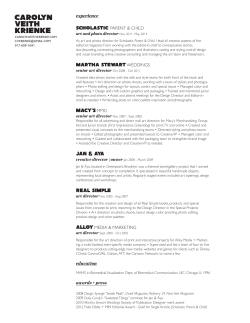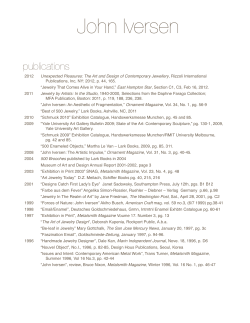
The treatment of white fluorosis spots by means of a
A Case Report The treatment of white fluorosis spots by means of a microinvasive approach: the infiltration method Marie Clement Because of the increasing demands on Dental Practices in the field of cosmetic treatment, it is essential to provide patients with the best therapies. In modern Practice, fluorosis-related whitish changes on the anterior teeth are a frequent reason for an aesthetic consultation. In the worst case, these fluorosis spots may cause psychological complications for patients. In fact an attractive smile may play an exceptionally important role in social and interpersonal relationships. For the treatment of lesions that appear visually as white spots, a very mild approach is recommended – the infiltration method. This method, which was originally developed to treat early carious lesions [7], may also be used to mask white spots thanks to a side effect, as it transforms the tooth’s optical properties. The original principle is based on an infiltrator penetrating the carious lesion after it has been conditioned with an acid and then dried [2] [9]. If white fluorosis spots are present, fluorosis-related hypomineralization produces a refractive index which differs from that of healthy tooth enamel. The lesion does not absorb any wavelengths and therefore appears white [5]. However, thanks to the infiltration into the porous lesion of a highly fluid resin material, which has a refractive index comparable to healthy enamel, it is possible to restore the enamel’s translucency [8]. This treatment can be carried out with maximum protection of tissue [4] [10]. Clinical case: Photo 1: A young female patient attends the Dental Practice. Her main concern is unsightly “white spots”. She would like to undergo treatment with anterior tooth veneers to mask the fluorosis spots completely. It is likely that the prophylactic dose has been exceeded for many years, as no fluoride status was determined beforehand. The clinical examination shows no carious lesions; the diagnosis of fluorosis is confirmed. According to Hattab’s classification [1] a class II fluorosis is present when it is characterized by symmetrical opaque discoloration. Page 1 of 2_10/2013 www.dmg-dental.com 1 4 2 5 3 6 Photo 2: External bleaching is performed on her as an outpatient by means of a vacuum-formed splint and 10% carbamide peroxide gel. The treatment, in which the splint is worn overnight, takes 21 days and the result is examined once a week at the Dental Practice. As bleaching increases the overall brightness of the teeth it acts as a mask for the smaller white flaws in the enamel. The visual result after bleaching may be satisfactory, but is insufficient. In fact, the opaque fluorosis spots have not been evened out enough by lightening the rest of the tooth. For this reason, an appointment is arranged to carry out the infiltration method one month after the end of the bleaching treatment. Photo 3: At the appointment for infiltration treatment prophylactic cleaning is carried out initially using a brush and prophylactic paste, in order to remove the biofilm and therefore the saliva proteins. By fitting a rubber dam a dry operating area is established. This step is especially important in order to protect the soft tissues when applying Hydrochloric Acid and to avoid any moisture during infiltration of the resin material. Photo 4: The next step is to establish access to the hypomineralized fluorosized lesions [5] [6]. The removal of heavily mineralized, aprismatic enamel on the surface of the lesions is required for this. This involves etching with 15% HCl gel (Icon-Etch, DMG) for 120 seconds [3]. The application of acid is carried out using the applicator tip supplied. To prevent uneven etching, which may be caused by bubbles arising from the gel, for example, the surface is mechanically activated with a microbrush. Icon-Etch is then suctioned off, a 30-second rinse using water spray is carried out and the surface blow-dried with oil and water-free air. Photo 5: Once the etching of the enamel is complete, it is important to remove the water contained in the microporous parts of the fluorosized lesions before infiltration with the resin material is carried out. The resin infiltrator (Icon-Infiltrant) is a hydrophobic Methacrylate resin matrix (TEGDMA). For this reason the lesions have to be dried thoroughly beforehand. This initially involves application of a 95% Ethanol solution (Icon-Dry). The alcohol is applied to the surface of the lesion using a blunt cannula for 30 seconds. At this stage, it is possible to monitor whether the white spots have disappeared or are significantly reduced and therefore draw conclusions about the potential outcome of the treatment. If the brightness of the lesions has not regressed enough this means the lesions’ micropores covered with a hypermineralized layer, are not yet completely accessible. In this situation the etching process should be repeated. Photo 6: Repetition of the etching process over a period of 120 seconds. A Case Report 7 9 Referenzen 1. Hattab FN et al. Dental discoloration: an overview. J Esth Dent 1999; 11:291-300. 8 10 2. Meyer-Lueckel H, Paris S. Progression of artificial enamel caries lesions after infiltration with experimental light curing resins. Caries Res. 2008;42(2):117-24. 3. Meyer-Lueckel H, Chatzidakis A, Naumann M, Dörfer CE, Paris S. Influence of application time on penetration of an infiltrant into natural enamel caries.J Dent. 2011 ; 39(7):465-9. Photo 7: After rinsing, drying and reapplying the Ethanol solution, the lesions appear much less bright this time and have almost disappeared. The lesions are now accessible for the resin material infiltration and it is possible to predict a satisfactory result. If, on the other hand, the white lesions are still recognizable after the second application of Icon-Dry, you should consider etching a third time. This is followed by the final drying process with oil and water-free air to allow the Ethanol to evaporate. After this drying process the lesions appear more pronounced (white-opaque, bright). This can be explained by the refractive index of air. Photo 8: At this stage the infiltration can be carried out, after the interdental matrices have been fitted. The resin material (Icon-Infiltrant) is applied using the enclosed applicator tip. The highly liquid hydrophobic resin material penetrates the porous parts of the lesions due to capillary forces. This process takes three minutes. As the resin material is light-curing, this step has to be carried out protected from light. The solvents are removed by spraying air and any excess material on the vestibular surface is removed using dental floss. Polymerization then takes place for 40 seconds before the infiltration stage is repeated the same way (resin material applied, and leaving it to take effect for one minute and polymerization for 40 seconds). This second infiltration helps reduce porosity on the surface. Photo 9: At the end of the session the rubber dam is removed and thorough polishing is carried out to prevent external Page 2 of 2_10/2013 www.dmg-dental.com discoloration in future. The excess material in the approximate area is removed using dental floss and fine grit polishing strips if necessary. The vestibular areas are polished with silicone tips. The final polish is performed with silicone carbide brushes, diamond pastes in combination with a goat’s hair brush and aluminum oxide paste in combination with a felt wheel. Photo 10: With this patient immediate improvement in her esthetic appearance was achieved. Checks were carried out every six months to evaluate the ageing of the resin material over time. With this minimally invasive treatment it was possible to achieve a benefit for the patient in terms of her smile, which has led to significant changes in her personal and social life. 4. Muñoz MA, Arana-Gordillo LA, Gomes GM, Gomes OM, Bombarda NH, Reis A, Loguercio AD. Alternative esthetic management of fluorosis and hypoplasia stains: blending effect obtained with resin infiltration techniques. J Esthet Restor Dent. 2013 Feb;25(1):32-9. 5. Newburn E, Brudevold F. Studies on the physical properties of fluorosed enamel. I. Microradiographic studies. Arch Oral Biol. 1960 ; 12:15-20. 6. Newburn E. Studies on the physical properties of fluorosed enamel. II. Microhardness. Arch Oral Biol. 1960 ; 12:21-7. 7. Paris S, Meyer-Lueckel H, Kielbassa AM. Resin infiltration of natural caries lesions. J Dent Res. 2007 ; 86(7):662-6. 8. Paris S, Meyer-Lueckel H. Masking of labial enamel white spot lesions by resin infiltration a clinical report. Quintessence Int. 2009 ; 40(9):713-8. 9. Robinson C, Brookes SJ, Kirkham J, Wood SR, Shore RC. In vitro studies of the penetration of adhesive resins into artificial caries-like lesions. Caries Res. 2001 ; 35(2):136-41. 10.Tirlet G, Chabouis HF, Attal JP. Infiltration, a new therapy for masking enamel white spots: a 19-month follow-up case series.Eur J Esthet Dent. 2013 Summer;8(2):180-90. Kontaktadresse Marie Clement Private Practice in Lyon, France Lecturer, Department of Operative Dentistry, University of Lyon, France 34 quai Charles de Gaule 69006 Lyon December 2013
© Copyright 2025





















